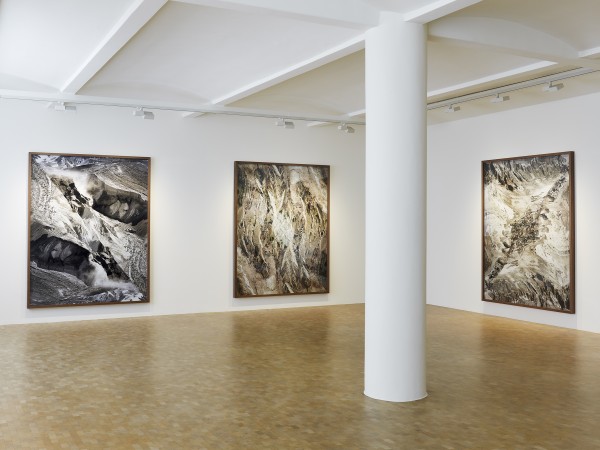Dan Holdsworth
Saturday, 17 May 2014
Work from Mirrors FTP.
“The mirror as a tool for the receptacle of representation has been utilised ever since the early progressions of the camera obscura and of course its traces are left within the very process of film-based photography, in regards to the imprint of light and time onto the negative and the subsequent process of chemical reversal. Within ‘Mirrors ftp’ Dan Holdsworth utilises the motif of the diagonal incision and an inversion of one half of the photographic image, creating a mirror effect where cascading boulders and winding ravines begin at either end and begin to centrally converge. Following ‘Forms ftp’ this newest series of images contain the photographs recorded in crater glacier in Washington (USA) but present a further scrutinising of imagery, a collision of glacial mass within a single solitary frame.
The ‘ftp’ of the title refers to what is known to scientists and astronomers as false topographic perception. Cited as a defect of long-distance cartographic techniques and remote sensor imaging, it is said that the recorded topographies of the moon and of mars have rendered aspects to be indistinguishably concave or convex, thus resulting in a lack of classification of mountainous and cavernous terrain. In turn this caused a multiplicity of issues with astronomical expeditions, as the photographic phenomenon has been a technical stumbling block ever since the topographic mapping of planetary landscapes began. Dan Holdsworth’s consideration of this phenomenon however, isn’t with an emphasis on the anecdotal of such occurrences, nor the formal aesthetics of this estranged scientific delineation; instead the artist explores a re-configured model of its affect.
It is the sentiment of ‘ftp’ that reveals itself within the photographic series – a sentiment that raises questions around certain empirical truths and how they are affixed to the mediated photographic form. What surfaces is the action of viewing and viewing again, or the suspended and contested perceiving of ‘realities’ within each photograph. In each ‘mirror’ a dualism appears; the preliminary doubting gaze is met with the secondary assertive glance – one to the other in a perplexing binary, it is perceived and persists anon.
It transpires that the consequence of a sudden inversion of the flow of visual matter can effect how we as the viewer categorize particular empirical details within an image. The ‘mirror’ of the work is thus conjured aesthetically, formally, but also reflexively as an awareness of one’s own perception of reading the work. The French 19th century philosopher Milan de Biran once coined the term ‘coenesthese’ to express ‘one’s immediate awareness of the presence of the body in perception’. Here, each fractured photograph begins to warrant a corporeal reading, a bodily reception, or a mind’s eye grasp on the looping rhythms contained within each pulsating dialogue of geological movement. ‘Mirrors ftp’ is thus embedded with undulating patterns that at once protrude and extrude, as if the very complexities of concave and convex forms are captured within the centre of each coloured plane.
It is clear that the diagonal motif of ‘Mirrors ftp’ is exemplary of a simple and refreshing intervention that represents that playful artist tactility with the photographic image: when a rotation and an incision render an experiential perspective entirely anew. The cut also represents the simplest of disruptions to the formal photographic plane, creating an image that essentially falls inwards – splintering perspective and stretching content into a renewed composition of rhythm and form.” – Joshua Wilson



